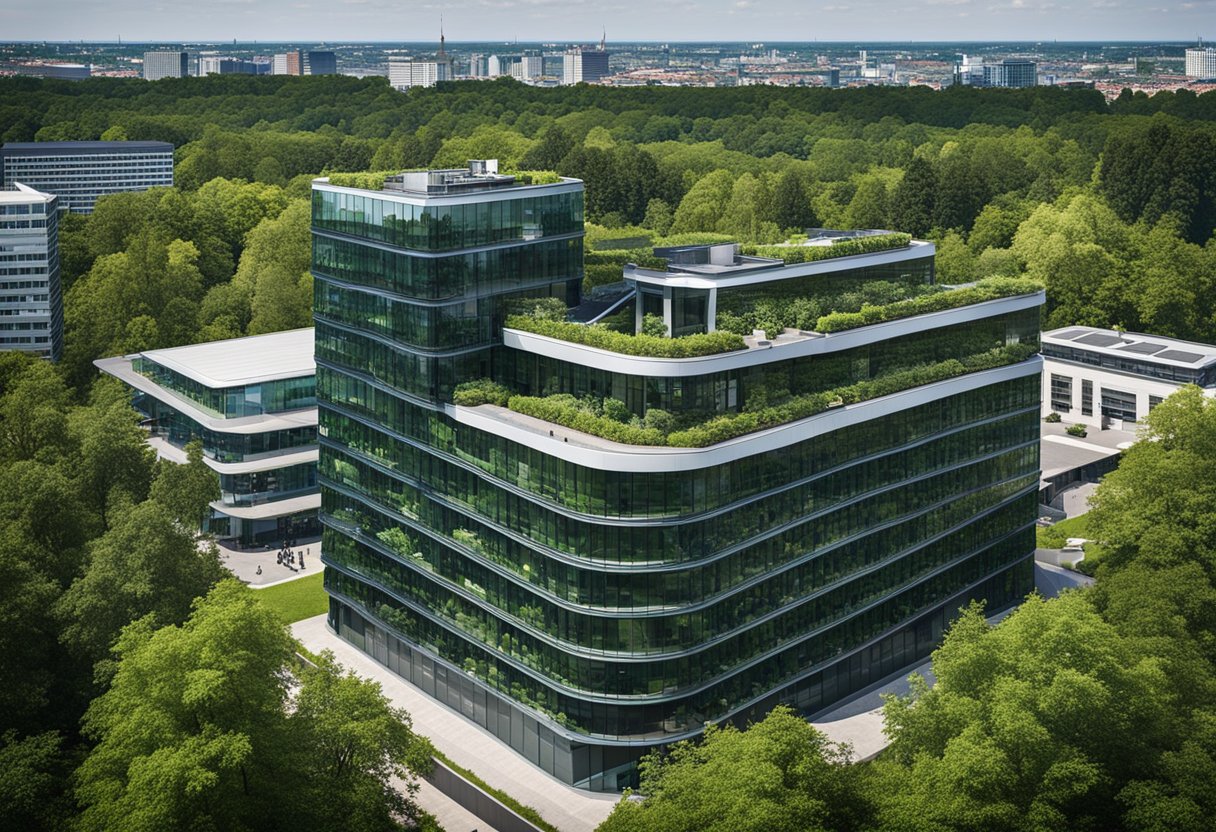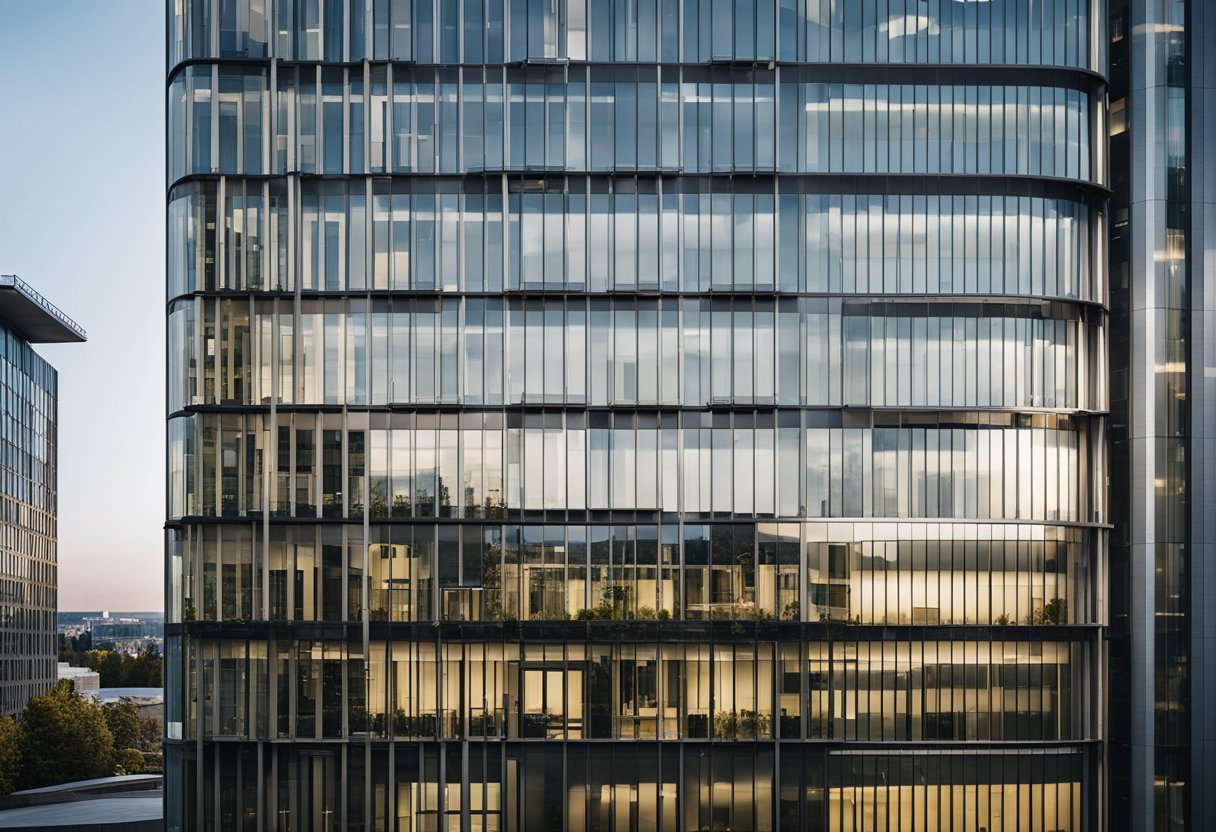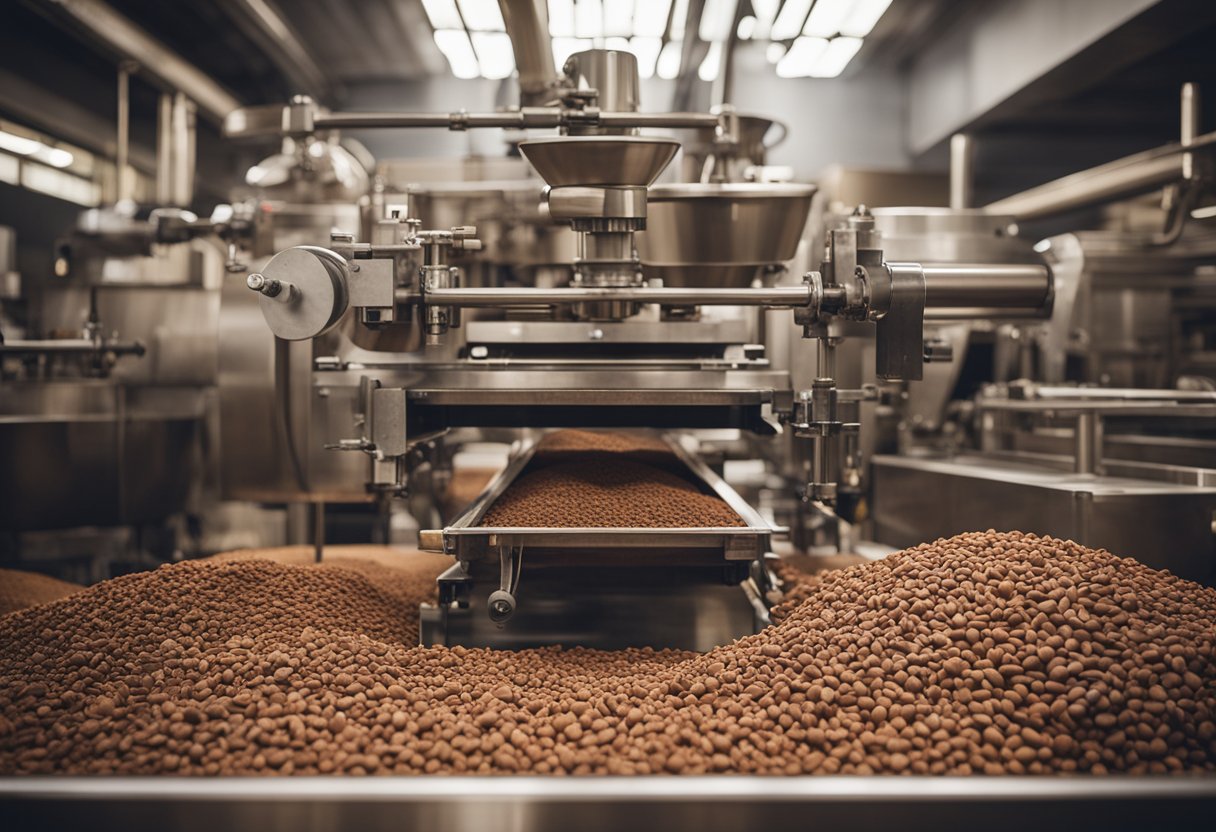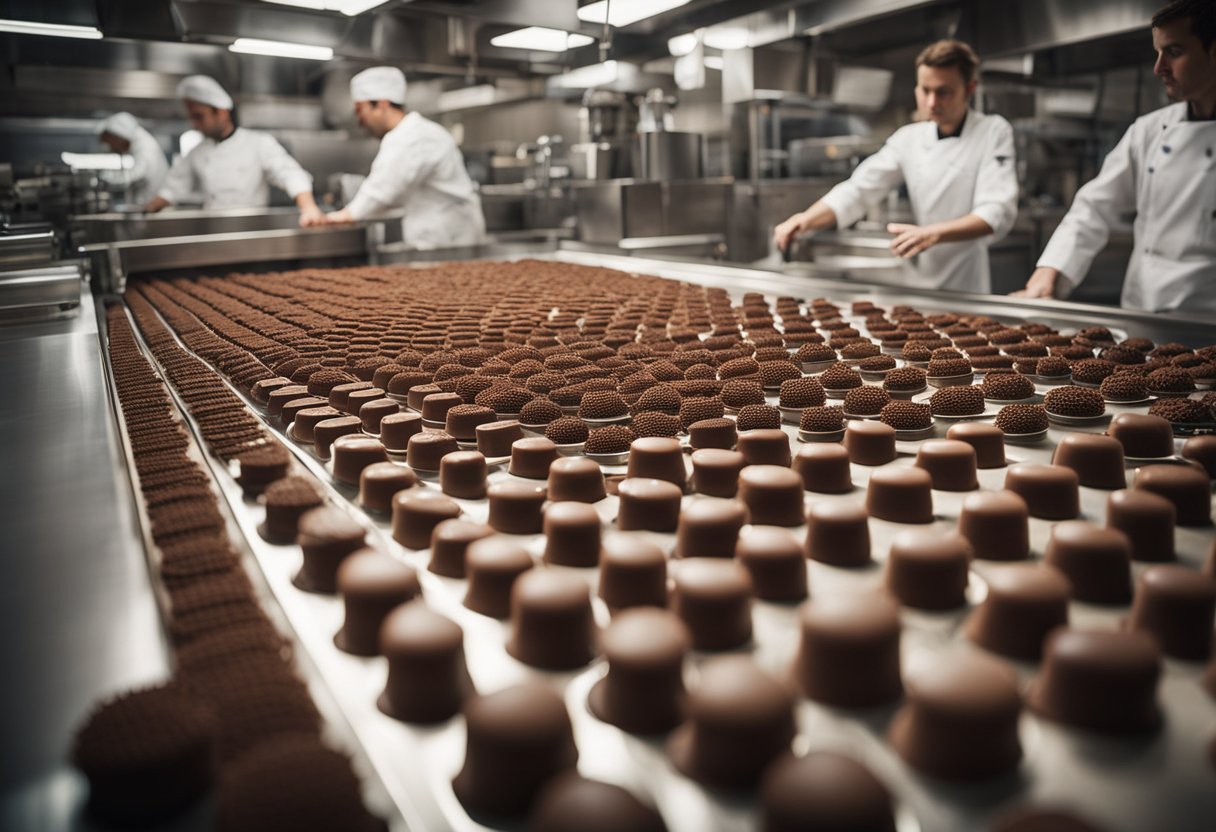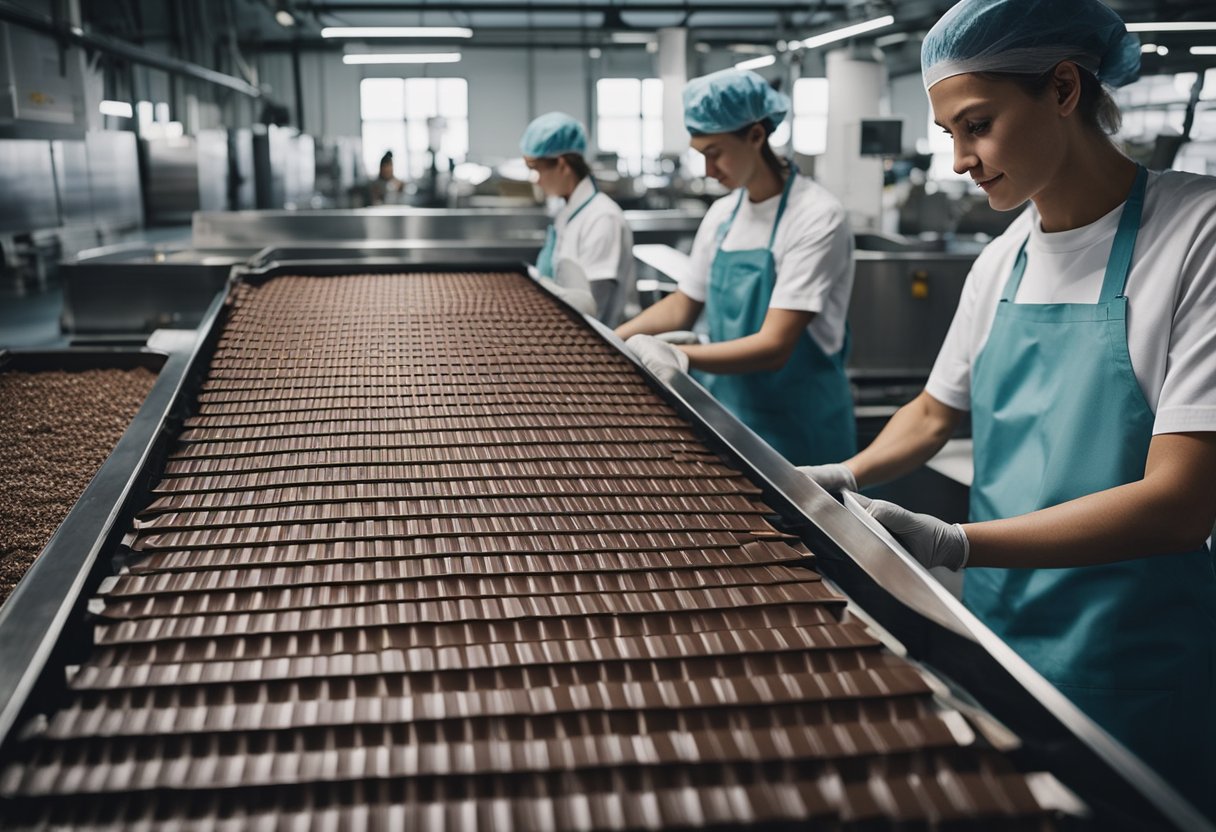Germany has a rich tradition in the confectionery sector, renowned for its quality and variety of chocolate.
A notable chocolate company that has established itself firmly within this tradition is August Storck KG, a significant confectionery producer headquartered in Berlin.
Known for its diverse range of sweets and chocolates, Storck’s presence in the German capital marks the city not only as a political and cultural hub but also as a center for confectionery craftsmanship.
Berlin, as the home of Storck, offers a plethora of chocolate experiences, including the famed Rausch Chocolate House.
It is a place where both locals and visitors can indulge in fine cocoa chocolate across a vibrant three-story space in the heart of the city.
The German chocolate industry, with Berlin as a key location, continues to be one of the main cocoa consumers and processors, contributing to the country’s reputation for producing high-quality chocolate products.
History of Chocolate in Berlin
Berlin’s chocolate history is rich and deep, marked by traditional confectioneries and influential chocolatiers. The city’s journey with chocolate is intertwined with cultural shifts and industrial advancements.
Origins and Development
The story of chocolate in Berlin began in the early 19th century, when cocoa beans arrived in German ports, fostering a new industry.
Pioneers like Joseph Emile Hachez, who moved to Germany in the late 1800s, established some of the foundational approaches to chocolate-making that would be built upon by German chocolate brands.
Known for their meticulous crafting methods, these early chocolatiers set high standards that would guide the industry for generations to come.
- August Storck, is a notable Berlin-based confectionery producer with a sizeable history.
- Berlin’s oldest praline manufacturer, Sawade, started shaping the city’s chocolate culture over 140 years ago.
Influence of German Chocolatiers
German chocolatiers have played a significant role in both the local and international chocolate scenes. Through innovation and commitment to quality, they have molded Berlin’s status as a chocolate hub. The impact of these chocolatiers is evident in:
- The diverse range of products available in the city.
- The evolution of techniques employed in chocolate manufacturing.
Berlin’s chocolate industry today features an array of companies from time-honored brands to innovative newcomers, each contributing to the fabric of the city’s chocolate narrative.
One such figurehead in the Berlin chocolate industry is Storck, a global name with its headquarters firmly planted in Berlin, continuing the legacy of the city’s chocolate history.
Major Berlin-Based Chocolate Manufacturers
Berlin, Germany is home to some of the world’s renowned chocolate manufacturers. The city’s rich history of chocolate making is embodied by these distinguished companies, each with its own unique approach to confectionery.
Ritter Sport
Ritter Sport is recognized globally for its distinct square-shaped chocolate bars. This Berlin-based manufacturer prides itself on a diverse range of flavors and a commitment to sustainability in its chocolate production.
Storck
Under the name August Storck KG, the company Storck conducts its operations, having a strong presence in Berlin. Known for a variety of confectionery beyond just chocolate, Storck has cemented its status as a key player in the sweet treats market.
Rausch Schokoladenhaus
Rausch Schokoladenhaus offers an immersive chocolate experience in the heart of Berlin. Their dedication to fine flavor cocoa chocolate places them at the forefront of high-quality chocolate retail in the city.
Sawade Berlin
Considered one of the oldest chocolate manufacturers in Berlin, Sawade Berlin has established a reputation for exquisite truffles and pralines, adhering to traditional chocolate-making techniques.
Belyzium Craft Chocolate
As an artisanal company, Belyzium Craft Chocolate takes a bean-to-bar approach, controlling every aspect of their chocolate making process. This dedication to craft produces premium chocolates with a focus on quality and sustainability.
Chocolate Production and Ingredients
In Berlin, Germany, companies like Cargill operate with a commitment to the craft of chocolate-making. Their production process and confectionery excellence emphasize high-quality cocoa beans and meticulously sourced ingredients.
Bean to Bar Process
The journey of chocolate from bean to bar is a delicate and precise one. It begins with the selection of the finest cocoa beans, which are thoroughly fermented and dried before being shipped to the production facilities.
Cargill’s chocolate plants in Berlin engage in every step of the way, from roasting to winnowing, ensuring that only the purest cocoa mass is produced.
Selection of Quality Ingredients
Quality ingredients are paramount in the creation of premium chocolate confectionery. Here are some key components:
- Cocoa Butter: Adds richness and texture.
- Sugar: Provides sweetness that complements the cocoa.
- Milk Powder: For making creamy milk chocolates.
- Lechithin: Often used as an emulsifier.
By upholding rigorous standards, chocolate companies in Berlin ensure a product that is not only delicious but consistently high in quality.
Product Range and Innovations
The Berlin-based Rausch Chocolate House has established itself with a diverse range of chocolate delicacies and a flair for innovation that appeals to a variety of tastes and preferences.
Types of Chocolate Offered
Rausch Chocolate House offers an extensive array of chocolate types catering to all preferences. Their product line includes:
- Milk Chocolate: Creamy and smooth, a classic favorite for all ages.
- Dark Chocolate: Rich and intense, with varying levels of cocoa content for connoisseurs.
- White Chocolate: Buttery and sweet, reimagined with innovative flavor infusions.
- Flavored Chocolates: Uniquely combined tastes such as mint or strawberry rhubarb.
Their selection extends to an assortment of chocolate bars, each inviting a unique taste experience. They also serve confections like truffles, pralines, and mousse au chocolat, delighting customers who seek more than just a simple chocolate bar.
Innovative Flavors and Combinations
Innovation at Rausch Chocolate House is demonstrated through:
- Chocolates with Fruits: Incorporation of berries, strawberries, and the unique strawberry rhubarb pairings.
- Chocolate Bars with Fillings: Combinations like caramel, nougat, and marzipan hidden within.
- Nut-Infused Chocolates: Hazelnut chocolate, offering a perfect blend of nutty crunch and smooth cocoa.
- Dessert-Inspired: Mousse au chocolat bars, capturing the essence of the classic dessert in a chocolate square.
Their willingness to explore surprising combinations, such as yogurt-flavored chocolates or the pairing of hazelnut with white chocolate, underscores their commitment to pushing the boundaries of traditional chocolate making.
Distribution and Availability
The Berlin-headquartered chocolate company August Storck KG, widely recognized under the business name Storck, showcases an impressive reach both within Germany and on an international scale.
Local Chocolate Shops
In Germany, Storck’s products are a common sighting in myriad chocolate shops including the iconic Kadewe and the charming Winterfeldt Schokoladen in Berlin, offering a wide range of selections to chocolate enthusiasts.
With commitments to quality and variety, inclusive of their renowned brands such as Moser Roth and Schogetten, they strongly influence the local market presence.
International Presence
Storck’s global footprint extends across Europe into countries like Denmark, Switzerland, and Belgium, known for their own rich chocolate cultures.
With their brands available on platforms like Amazon, even those at the farthest reaches have access to Storck’s exquisite chocolate.
Additionally, strategic availability in popular retail chains such as Aldi, allows Storck to cater to a broader audience worldwide, augmenting their international presence and ensuring the Hachez Chocolate elegance and Hussel’s confectionery delights are never too far away for any global consumer.
Chocolate Brands and Their Significance
The discussion of chocolate brands often centers on their geographic origins which relate to distinct styles and traditions in chocolate making.
German Chocolate Brands
One of the notable German chocolate brands is Ritter Sport, renowned for its square chocolate bars and variety of flavors.
The company is headquartered in Waldenbuch, Germany, and has become a symbol of German ingenuity in confectionery.
Aside from Ritter Sport, the German chocolate market also features brands like Milka, Moser Roth, and Schogetten, each with its own unique offerings.
Milka, recognized by its purple cow emblem, has been a staple of German chocolate since the early 20th century.
Moser Roth is another prestigious brand, known for its premium quality and a range of indulgent flavors.
Schogetten, meanwhile, offers chocolate in a segmented format, allowing consumers to enjoy high-quality chocolate in convenient, bite-sized pieces.
Comparisons with Swiss and Belgian Chocolates
German chocolates stand alongside those of Switzerland and Belgium, both of which are acclaimed for their chocolate-making traditions.
Swiss chocolates are celebrated for their smooth texture and high-quality milk, giving rise to brands like Lindt and Toblerone. Belgian chocolates, synonymous with luxury, often feature a higher cocoa content and a variety of unique fillings.
The distinction among German, Swiss, and Belgian chocolates is not just in their taste or quality but also in their approach to chocolate-making.
Swiss chocolatiers typically emphasize creaminess and a melt-in-the-mouth quality, whereas Belgian chocolates are known for their artisanal techniques and decorative craftsmanship.
German chocolates offer a wide range of flavors, often incorporating a variety of ingredients that reflect Germany’s rich confectionery history.
Sustainability and Ethical Practices
In the realm of chocolate production, sustainable and ethical practices are increasingly significant.
Emphasis is placed on the direct trade with cocoa farmers to ensure fair compensation and on cultivating organic cocoa that supports the ecosystem.
Direct Trade Initiatives
Direct trade is a key element in upholding ethical standards within the chocolate industry.
By engaging in direct trade, companies headquartered in Berlin, like others, can foster transparent relationships with cocoa farmers, particularly in regions such as South America, Africa, and Latin America.
This not only guarantees fair prices for the farmers’ produce but also helps in maintaining a sustainable supply chain.
Support for Cocoa Farmers
Support for cocoa farmers translates into practices that extend beyond fair financial compensation.
Initiatives often include providing farmers with organic farming training and resources to improve soil fertility and yield without harming the environment.
The cultivation of organic cocoa is instrumental in preserving biodiversity and can mitigate detrimental environmental impacts usually associated with conventional cocoa farming.
Cultural Impact and Consumer Perceptions
The intricate relationship between German heritage and chocolate reflects the cultural significance of the confectionery and the evolving consumer trends.
This section examines how chocolates from Germany resonate with consumers and the status they hold within the cultural fabric of the nation.
Consumer Trends
German chocolatiers have been successful in aligning their offerings with the shifting preferences and perceptions of consumers.
Today, chocolate is not just a sweet treat; it is an experience shaped by quality and tradition.
As connoisseurs seek out authentic and unique flavors, Berlin-based chocolate companies have responded by crafting exquisite chocolates that embody the heart of German precision and creativity.
- Preferences for Sustainability: Consumers increasingly favor chocolates that are produced ethically and sustainably, aligning with broader cultural concerns.
- Artisanal and Boutique Offerings: There is a growing trend for artisanal chocolates, with a focus on small-batch, high-quality products.
Chocolates as Part of German Heritage
Chocolate has a special place in the heart of Germany’s culinary traditions, which is evident in the wide variety of sweet treats available throughout the country.
Rüdesheimer Kaffee, for example, is a popular beverage that combines coffee with the distinctive flavors of German chocolate and brandy.
- Historical Significance: For centuries, German heritage has embraced chocolate; it’s been a symbol of luxury, craftsmanship, and cultural identity.
- Chocolates from Germany: Revered around the world, these chocolates are often considered the standard for premium quality in the industry.
Through the dedication of skilled chocolatiers and the discerning palates of connoisseurs, chocolate remains an integral part of Germany’s cultural and gastronomic landscape.
Frequently Asked Questions
In exploring the rich landscape of chocolate companies headquartered in Berlin, Germany, the following frequently asked questions shed light on key industry players and notable historic events within this sector.
What are the most well-known chocolate manufacturers based in Berlin?
The most well-known chocolate manufacturers based in Berlin include the Rausch Chocolate House, known for its fine flavor cocoa chocolate, and other significant brands such as Ritter Sport and Milka that have strong presences in the city.
What is the famous German chocolate factory?
The famous German chocolate factory that calls Berlin its home is the Rausch Chocolate House, a major destination for chocolate enthusiasts, offering a vast selection of chocolates over multiple floors.
Which country is the origin of Storck chocolate products?
Storck chocolate products originate from Germany, where the company has established a robust reputation for its confectionery products since its foundation.
Can you list some of the products made by August Storck?
Some of the products made by August Storck include Merci chocolates, Werther’s Original, Knoppers, and Toffifee, all widely enjoyed and recognized internationally.
Who are the primary shareholders of the August Storck company?
The primary shareholders of the August Storck company are members of the Storck family, maintaining a privately owned structure for the business.
What is the history of Storck as a chocolate company?
The history of Storck as a chocolate company began in 1903 when August Storck founded the company in Werther, which has since grown to become one of Germany’s well-respected confectionery manufacturers with a global presence.
